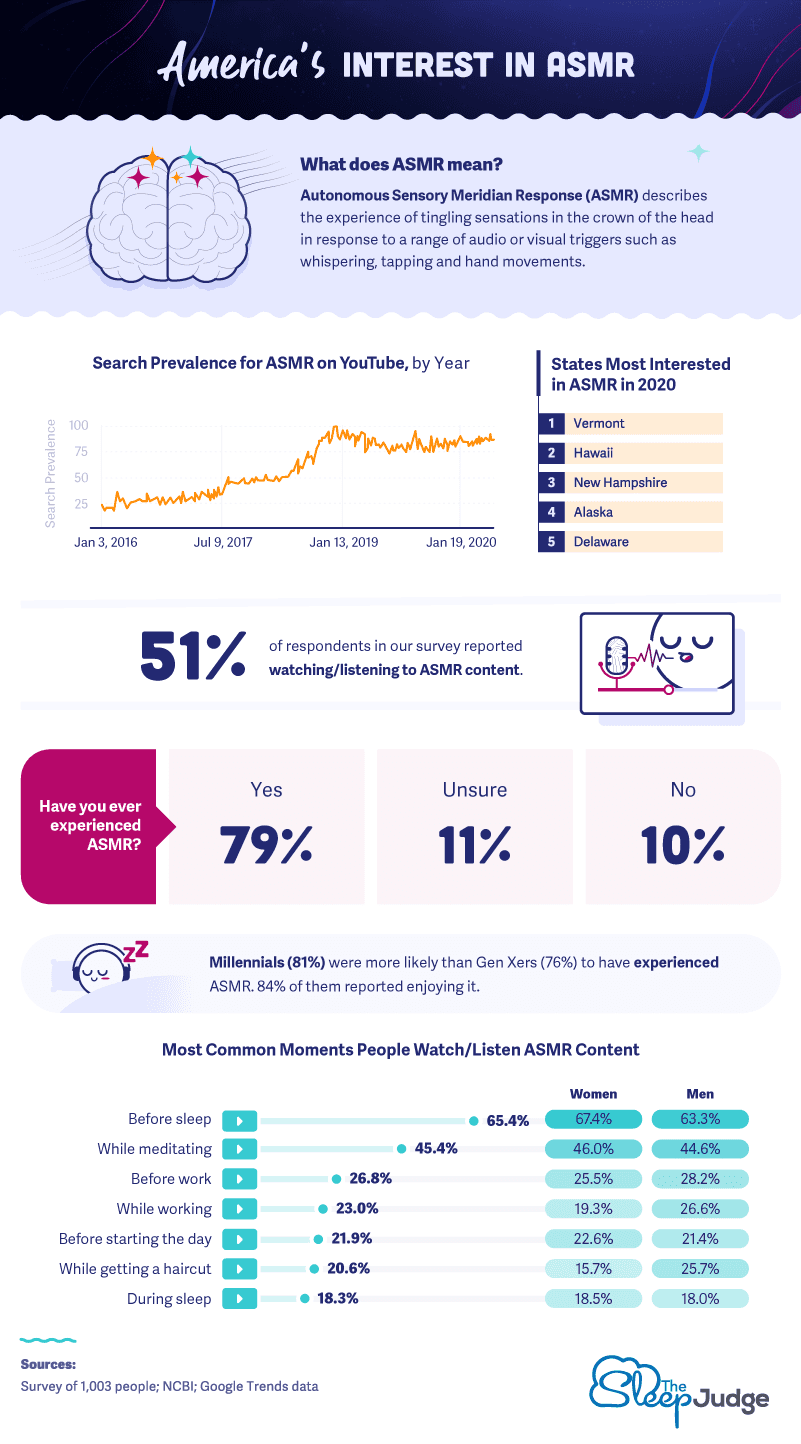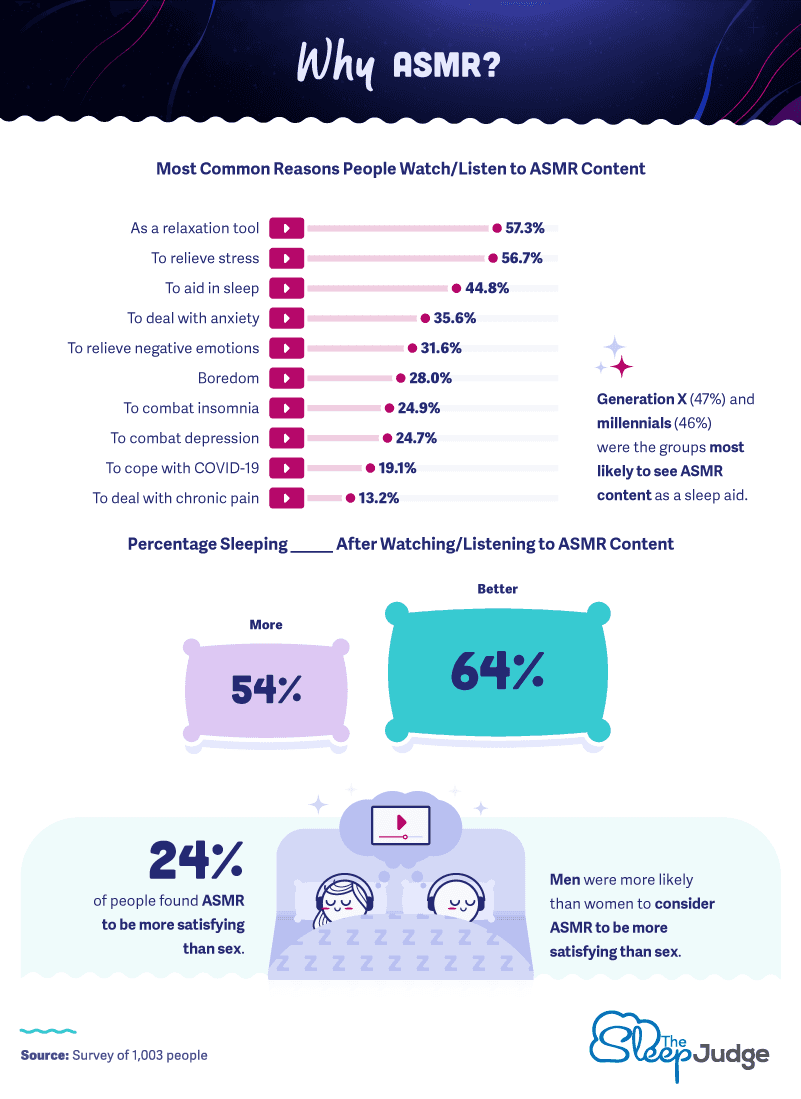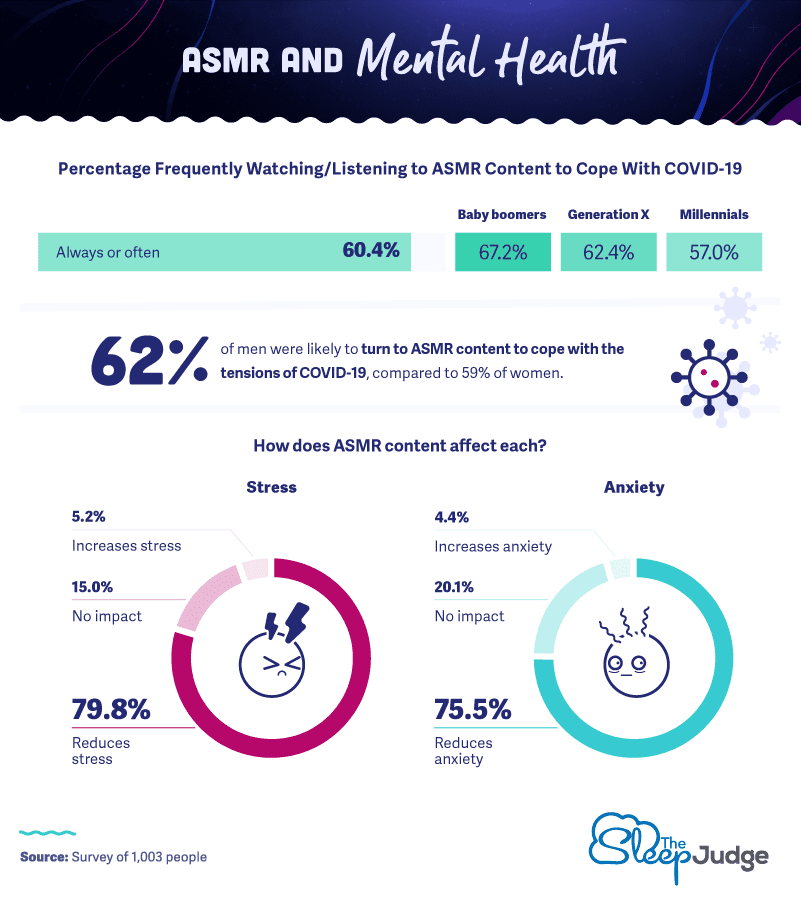If you’ve never heard of ASMR videos, please allow us to introduce what may possibly be your new best friends. ASMR, which stands for Autonomous Sensory Meridian Response, describes the tingling experiences a person feels from various relaxing stimuli, like getting your head scratched or hearing someone whisper. The videos around the topic are exploding in popularity – and for good reason: They can help you relax. And fast.
Before you write ASMR off as something that’s too good to be true, know that we spoke to more than 1,000 people across the country on the topic, noting the personal benefits they cited, how certain videos made them feel, and how ASMR has helped them in their everyday life. They also shared their particular favorites and even compared ASMR to other destressor alternatives, like sex. If you’re looking for a place to get started or just curious on the topic, keep reading.
United States of Relaxation
Our study begins with a look at the overall popularity of ASMR both over time and in the present. We looked at Google Trends, state-by-state data, and our participant responses to glean this top-level information.
More than half of the respondents we spoke to had already listened to some type of ASMR regularly. Another 79% had had some type of experience with the content. In all likelihood, these numbers will only grow in the future, especially if Google Trends is any indication. Though the trend originally kicked off on YouTube in 2013, more and more people across the globe are entering searches related to ASMR and enjoying its content across a variety of platforms.
The surge in popularity is mostly being driven by millennials: 81% have watched ASMR, and 84% of them enjoyed it. That said, the value is certainly not lost on other age groups. More than three-quarters of Gen X have also spent time watching ASMR. Mostly, people are watching and/or listening to the content before they go to sleep (65.4%) or as a meditation aid (45.4%).
Reasons Why
So what exactly is the driving force behind this growing interest in ASMR? The next part of our study seeks to answer this question. We asked respondents their top reasons for engaging in the content, broke down the responses by generation, and even asked people to compare its satisfaction to sex.
Even though bedtime was the most common time to enjoy ASMR, sleep was not the number one reason people turned to the content. Instead, general relaxation and anxiety reduction were cited as the top motivations. The rise of stress and generalized anxiety in the U.S. has long been documented, so it’s encouraging that a new and relatively healthy coping mechanism is reaching so many.
Nevertheless, sleep was a huge factor in ASMR success and enjoyment. Gen X and millennials were the two most likely groups to use ASMR as a tool to induce sleep. In addition to rising levels of anxiety, rising levels of sleeplessness are also gripping the U.S. Thankfully, the results of ASMR appear promising: 54% reported sleeping more with ASMR, and 64% reported sleeping better.
Therapy Through ASMR
With sleep and anxiety being so closely linked to mental health, it seemed logical that ASMR might, by the transitive property, be as well. The next portion of our study dives into ASMR’s ability to help people cope with stress, or more specifically, COVID-19-related tensions.
Three out of 5 respondents reported turning to ASMR always or often to deal with COVID-19-related tensions. This may also help explain the particular uptick in recent months seen on Google Trends earlier in the study. Men and baby boomer respondents were even more likely to say this is the primary reason they turn to ASMR.
Even in the face of something as stressful as a pandemic, ASMR, evidently, is working. A whopping 80% agreed that they felt less stressed after watching related content, and nearly 76% said they felt less anxious – all without a pill or a trip to the doctor. It might just be time to enter a Google search of your own.
Most Beloved Classics
Before wrapping up, our study asked respondents to share their particular favorites – should you need a little inspiration of your own. They shared their most preferred ASMR triggers, but we also compiled an official list of the most popular ASMR content available for you on the internet today.
Women were most likely to enjoy the sound of water drops while men were most often wanting to watch massage videos. Millennials sided with women and also enjoyed water drops the most, while Gen X went with the men’s choice and opted for massage videos. Things like whispering and personal attention also proved very popular. Less so were things like typing (just 18% chose this as their favorite) and tapping (19%).
The most popular ASMR video on YouTube, however, involved none of these things. Instead, it’s a video of mixing store-bought slime with clear slime. This video has racked up 705.4 million views, and counting. If videos like this are appealing to you, try searching through some of the most popular channels, which are also listed in the infographic above.
ASMR and Your Health
Could ASMR really be the thing to save us all during the pandemic? Maybe not by itself, but it’s sure off to a great start. Respondents across all generations who watched ASMR reported sleeping more, sleeping better, reducing stress, and alleviating anxiety. Considering it’s entirely natural and doesn’t involve expensive doctors visits or confusing medication, it may be worth a click or two, especially before bedtime.
If you are having any problems sleeping or think you have room for improvement, you likely need more than ASMR. At The Sleep Judge, we have all the sleep resources you could possibly need. Whether you’re looking for mattress or information on the next greatest pillow, our team of sleep experts is ready to assist you in any way you need. Head to The Sleep Judge today to see how we can help!
Methodology and Limitations
We surveyed 1,003 people who watch ASMR videos. Fifty-one percent of respondents were women, and 49% were men. Respondents’ ages ranged from 23 to 60 years old with an average age of 37 and a standard deviation of nine years.
For short, open-ended questions, outliers were removed. To help ensure that all respondents took our survey seriously, they were required to identify and correctly answer an attention-check question.
These data rely on self-reporting by the respondents and are only exploratory. Issues with self-reported responses include, but aren’t limited to, the following: exaggeration, selective memory, telescoping, attribution, and bias. All values are based on estimation.
We extracted data from YouTube’s API to determine the most popular ASMR channels and videos on YouTube.
Fair Use Statement
Feeling relaxed just thinking about ASMR? Share this research with someone who would also enjoy a little stress relief. Just be sure your purposes are noncommercial and that you link back to this page to provide proper credit.




